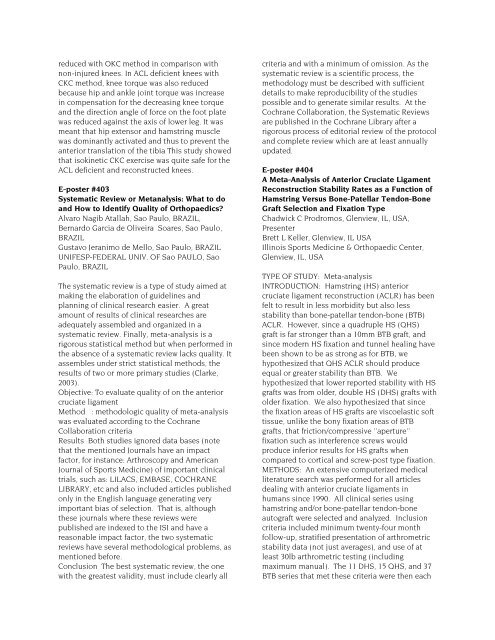POSTER ABSTRACTS - ISAKOS
POSTER ABSTRACTS - ISAKOS
POSTER ABSTRACTS - ISAKOS
You also want an ePaper? Increase the reach of your titles
YUMPU automatically turns print PDFs into web optimized ePapers that Google loves.
educed with OKC method in comparison with<br />
non-injured knees. In ACL deficient knees with<br />
CKC method, knee torque was also reduced<br />
because hip and ankle joint torque was increase<br />
in compensation for the decreasing knee torque<br />
and the direction angle of force on the foot plate<br />
was reduced against the axis of lower leg. It was<br />
meant that hip extensor and hamstring muscle<br />
was dominantly activated and thus to prevent the<br />
anterior translation of the tibia This study showed<br />
that isokinetic CKC exercise was quite safe for the<br />
ACL deficient and reconstructed knees.<br />
E-poster #403<br />
Systematic Review or Metanalysis: What to do<br />
and How to Identify Quality of Orthopaedics?<br />
Alvaro Nagib Atallah, Sao Paulo, BRAZIL,<br />
Bernardo Garcia de Oliveira Soares, Sao Paulo,<br />
BRAZIL<br />
Gustavo Jeranimo de Mello, Sao Paulo, BRAZIL<br />
UNIFESP-FEDERAL UNIV. OF Sao PAULO, Sao<br />
Paulo, BRAZIL<br />
The systematic review is a type of study aimed at<br />
making the elaboration of guidelines and<br />
planning of clinical research easier. A great<br />
amount of results of clinical researches are<br />
adequately assembled and organized in a<br />
systematic review. Finally, meta-analysis is a<br />
rigorous statistical method but when performed in<br />
the absence of a systematic review lacks quality. It<br />
assembles under strict statistical methods, the<br />
results of two or more primary studies (Clarke,<br />
2003).<br />
Objective: To evaluate quality of on the anterior<br />
cruciate ligament<br />
Method : methodologic quality of meta-analysis<br />
was evaluated according to the Cochrane<br />
Collaboration criteria<br />
Results Both studies ignored data bases (note<br />
that the mentioned Journals have an impact<br />
factor, for instance: Arthroscopy and American<br />
Journal of Sports Medicine) of important clinical<br />
trials, such as: LILACS, EMBASE, COCHRANE<br />
LIBRARY, etc and also included articles published<br />
only in the English language generating very<br />
important bias of selection. That is, although<br />
these journals where these reviews were<br />
published are indexed to the ISI and have a<br />
reasonable impact factor, the two systematic<br />
reviews have several methodological problems, as<br />
mentioned before.<br />
Conclusion The best systematic review, the one<br />
with the greatest validity, must include clearly all<br />
criteria and with a minimum of omission. As the<br />
systematic review is a scientific process, the<br />
methodology must be described with sufficient<br />
details to make reproducibility of the studies<br />
possible and to generate similar results. At the<br />
Cochrane Collaboration, the Systematic Reviews<br />
are published in the Cochrane Library after a<br />
rigorous process of editorial review of the protocol<br />
and complete review which are at least annually<br />
updated.<br />
E-poster #404<br />
A Meta-Analysis of Anterior Cruciate Ligament<br />
Reconstruction Stability Rates as a Function of<br />
Hamstring Versus Bone-Patellar Tendon-Bone<br />
Graft Selection and Fixation Type<br />
Chadwick C Prodromos, Glenview, IL, USA,<br />
Presenter<br />
Brett L Keller, Glenview, IL USA<br />
Illinois Sports Medicine & Orthopaedic Center,<br />
Glenview, IL, USA<br />
TYPE OF STUDY: Meta-analysis<br />
INTRODUCTION: Hamstring (HS) anterior<br />
cruciate ligament reconstruction (ACLR) has been<br />
felt to result in less morbidity but also less<br />
stability than bone-patellar tendon-bone (BTB)<br />
ACLR. However, since a quadruple HS (QHS)<br />
graft is far stronger than a 10mm BTB graft, and<br />
since modern HS fixation and tunnel healing have<br />
been shown to be as strong as for BTB, we<br />
hypothesized that QHS ACLR should produce<br />
equal or greater stability than BTB. We<br />
hypothesized that lower reported stability with HS<br />
grafts was from older, double HS (DHS) grafts with<br />
older fixation. We also hypothesized that since<br />
the fixation areas of HS grafts are viscoelastic soft<br />
tissue, unlike the bony fixation areas of BTB<br />
grafts, that friction/compressive ''aperture''<br />
fixation such as interference screws would<br />
produce inferior results for HS grafts when<br />
compared to cortical and screw-post type fixation.<br />
METHODS: An extensive computerized medical<br />
literature search was performed for all articles<br />
dealing with anterior cruciate ligaments in<br />
humans since 1990. All clinical series using<br />
hamstring and/or bone-patellar tendon-bone<br />
autograft were selected and analyzed. Inclusion<br />
criteria included minimum twenty-four month<br />
follow-up, stratified presentation of arthrometric<br />
stability data (not just averages), and use of at<br />
least 30lb arthrometric testing (including<br />
maximum manual). The 11 DHS, 15 QHS, and 37<br />
BTB series that met these criteria were then each
















